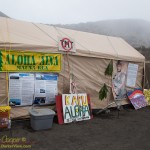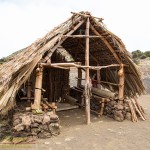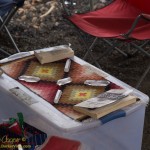A night on the summit and a stay at Hale Pōhaku offers an opportunity to explore the mountain. The plan had been to take a short hike in the Hale Pōhaku area to visit some interesting geologic features before heading down the mountain. A cold misting rain made that idea much less attractive. Instead I paid a visit to my friends at the Visitor Information Station and along the way visited the protest camp across the street. The experience of the day was a conversation I had with the occupants of the camp, a conversation both interesting and odd, I spent the entire drive back down the mountain and much of the day mulling over what I had seen and heard in that conversation.

The first to greet me as I came across the street was a gentleman I will call Mr. Sovereignty for his position on the matter. The argument atop Mauna Kea has become embroiled in a range of issues that have simmered in the islands for a long time. Among those who are against the construction of TMT are some who are simply against any further telescopes on Mauna Kea and also those who see the issue as wrapped up in questions on the legal status of the State of Hawaii. The main thrust of a common argument is that the Kingdom of Hawaii was illegally overthrown. Their goal is nothing less than the restoration of the kingdom as a sovereign entity.
I fully agree that the overthrow was illegal, the US government Blount report answers that question. The question is what happened after that, how we got from the provisional government to the modern State of Hawaii. Here is where our view of history differs, for a quick view close to my own conclusions I will simply refer to an excellent summary by Ian Lind.

I enjoyed my talk. Here is a gentleman who has clearly read his history. He may be drawing different conclusions from the events, but that is the nature of history, we all see it from our point of view. From the overthrow and the immediate after effects, the Blount Report and the reactions by the United States government to the overthrow of Queen Liliʻuokalani. Our conversation covered a time of tumultuous history that forms the foundation of the State of Hawaii, those years are more important that any other period in island history.
Mr. Sovereignty’s professed wish was to see a restored Hawaiian Kingdom in his lifetime. Personally I think that a restored Kingdom holds little promise of a better future, that for all its flaws the State of Hawaii is a better recipient of the hopes of the people of these islands. It would be interesting to see the validity of the Hawaiian Kingdom again tested in court, but think that any such legal effort would ultimately fail for lack of merit. What is needed now are better solutions for the social issues that have led to the frustration of many island residents.
Given the suspension of construction efforts and the miserable weather it is not surprising that there were only a handful of people at the protest site. While I and Mr. Sovereignty talked a few others joined. Among them were a pair of women who introduced themselves as members of the occupy movement from the mainland. They also expressed strong views supporting the protest.
Mrs. Occupy clearly had a shallow understanding of the history of the islands, her choice of words was extreme and left no room for the complex interplay of cultures that has created modern Hawaii. One thing she seemed incensed about was the “slavery” that ran the sugar plantations. The labor imported to the islands was many things, and the system was certainly abusive. But the workers did choose to emigrate and they were paid, and many succeeded in building a place for themselves and their families after working in the plantations. The plantation owners deliberately brought in different ethnic groups in order to stifle cooperation between the workers; Chinese, Filipino, Japanese, Korean and more. This led to the rich history of our Hawaiian pidgin language, labor organization and the beginning of the very multicultural society that we enjoy today. Like many episodes of history, there was the good and the ugly side of humanity on display.
Her other comments were similarly peppered with words and expressions that betrayed her simplistic understanding of the issue. This echoes other conversations I have read in the local papers and online. For a citizen of the US her professed views were outright treasonous, declaring the invalidity of the US government. While I understand the the US government has issues her statements went way beyond this.
It was Mrs occupy’s companion that seemed more interested in our conversation, asking intelligent questions. She was learning in a way that was an stark contrast to the resistant Mrs. Occupy. Had we met in another place, over another issue, she and I may have found much in common to discuss. I generally agree with many of the goals pursued by the global occupy movement. A push-back against corporate influence and power, social equality, increased freedoms and better transparency in government, these I can agree with.

Many groups have allied with the Hawaiians protesting construction on the mountain. From the environmental groups, the occupy movement, new age spiritualists, and more. I do not believe any of these other groups add anything to the conversation other than making a lot of noise and obscuring the real issues involved. Much of the information they attempt to convey is exaggerated or outright inaccurate. The online and media attention has attracted many who seek to push their personal and their organization’s agendas.
As the conversation wound down I shook hands and embraced Mr. Sovereignty. For all our disagreement we understood the island spirit of aloha and the Kapu Aloha that the protesters have imposed. It is a truly Hawaiian way of recognizing that even in the most serious dispute, we realize that at the end of the day we share a small island. I am not sure that the others involved with the day’s conversation understood that. Certainly I saw no recognition of this in Mrs. Occupy’s demeanor as I bid goodbye, all I saw was disdain on her face.

